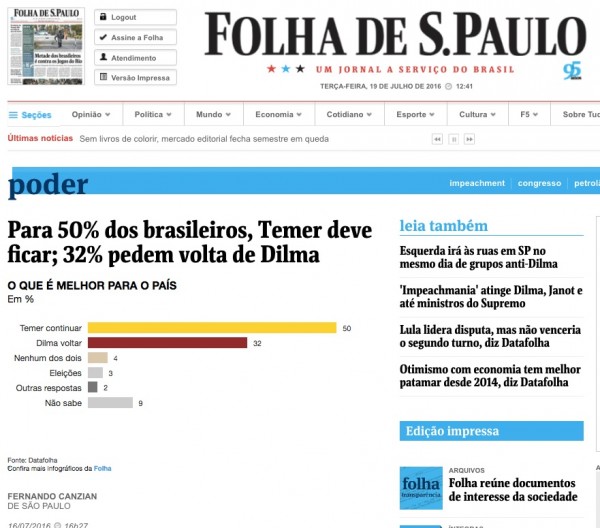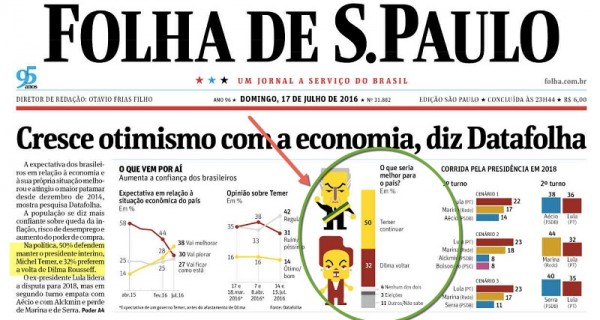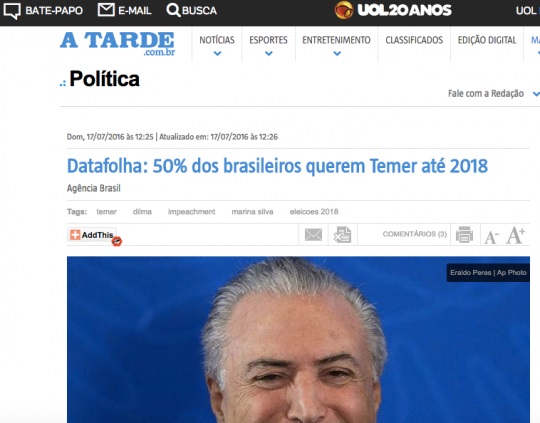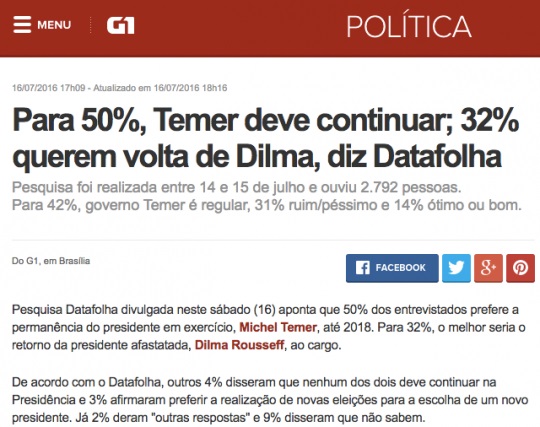

Follow us on:  
|

One of the looming mysteries during the last several months of Brazil’s political crisis (as The Intercept has repeatedly noted) has been the complete absence of polling data from the country’s largest media outlets and polling firms. The lower house voted on April 17 — more than three months ago — to send to the Senate impeachment charges against democratically elected President Dilma Rousseff, which resulted in the temporary installation of her vice president, Michel Temer, as “interim president.”
Since then, there had been no published polls from Datafolha — the polling firm used by Brazil’s largest newspaper, Folha de.S Paulo — asking Brazilians if they favor Dilma’s impeachment, if they favor the impeachment of Temer, and/or if they want new elections to choose a new president. The last Datafolha poll prior to the impeachment vote was on April 9, and it found that 60 percent favored Dilma’s impeachment, while 58 percent favored the impeachment of Temer. It also found that 60 percent wanted Temer to resign after Dilma was impeached, and 79 percent favored new elections once they both left.
The last poll from the other major firm, Ibope, was published on April 25, and it found that 62 percent wanted both Dilma and Temer to leave office and then new elections held; 25 percent wanted Dilma to remain and complete her term; and only 8 percent favored what has happened thus far: that Dilma is removed and Temer remains as president. Still, that poll — as bad as it was for Temer — was all the way back in April.
Incredibly, even though Temer was installed more than three months ago, the Senate is just weeks away from a final vote on Dilma’s impeachment, and the world’s eyes will be on Brazil when the Olympics begin in two weeks, there had been no new polls published — until this weekend. On Saturday, Folha de S.Paulo trumpeted a major new poll from Datafolha that was as surprising as it was positive for interim President Temer. It was also a radical departure from prior polls. The top headline promoted by Folha, which quite predictably went all over the country very quickly, announced that half of the country now wants Michel Temer to remain president through the end of what would have been the end of Dilma’s term in late 2018.
With the final impeachment vote imminent, that is an extremely significant finding: that 50 percent of Brazilians think it’s best for the country if Temer completes Dilma’s term. At least as significant was Folha’s claim that only 4 percent said they want neither Dilma nor Temer to stay, while only 3 percent want new elections. This was from Saturday’s lead online article:

[HEADLINE: “For 50% of Brazilians, Temer should remain; 32% want Dilma to return”
POLL GRAPHIC: “What is best for the country?
Temer continues: 50%;
Dilma returns: 32%;
Neither of the two: 4%;
Elections: 3%;
Other responses: 2%;
Don’t know: 9%]
The paper also blasted this result on the front page of its Sunday print edition, the most-read edition of any newspaper in Brazil:

[Highlighted paragraph: “In politics, 50% advocate that Michel Temer remain as president, and 32% prefer the return of Dilma Rousseff.”
Highlighted graphic: “What would be best for the country? Temer continues: 50%; Dilma returns: 32%; Neither of the two: 4%; Elections: 3%; Other/don’t know: 11%]
Not only was this result shocking given the widespread animus toward Temer revealed by prior polls, but it also made no sense on its own terms. To begin with, other Datafolha questions that asked who voters preferred to become president in 2018 showed that Temer was at only 5 percent, compared with the poll leader, former President Lula da Silva, who was between 21 and 23 percent, followed by Marina Silva at 18 percent. Moreover, only 14 percent approve of Temer’s new government (compared to 31 percent who strongly disapprove and 41 percent who are neutral). Beyond that, a full one-third of Brazilian voters can’t even name Temer as their current president. And, as one left-wing site noted in denouncing this latest polling headline from Folha as a “statistical fraud,” it is simply inconceivable that the percentage of Brazilians favoring new elections fell from 60 percent in April to 3 percent now, while the percentage wanting Temer to remain as president skyrocketed from 8 percent to 50 percent.
All of those facts made it extremely difficult to understand how Folha’s top-line headline — that 50 percent want Temer to remain as president through the completion of Dilma’s term – could possibly be true. It’s contrary to all known data. But Folha is the country’s largest paper; Datafolha is a reasonably credible polling firm; and they were unequivocal in their headline and lead graphic about this result. Despite all these obvious grounds for doubt, Folha did not publish the actual questions asked nor the underlying data with this article, so it was impossible to fact-check their claims.
As a result, this headline — that half the country want Temer to remain as president through 2018 — was heralded by most media outlets and instantly became ingrained as fact: as a potentially lethal fact that could easily seal the deal against Dilma. After all, if 50 percent of the country literally want Temer as their president through 2018, it’s hard to see how fence-sitting senators will deny them what they want.
But yesterday, the full data and underlying questions were made public. It is now evident that — whether through corrupt motives or utter ineptitude — a journalistic fraud has been committed by Folha. The reason only 3 percent of Brazilians said they want new elections, and only 4 percent said they want neither Dilma nor Temer to remain as president, is because the poll question excluded those as options. As the journalist Alex Cuadros noted today, the actual question that was asked only gave respondents two options: either (1) Dilma returns or (2) Temer stays through 2018.

[Question 13: “In your opinion, what would be better for the country: that Dilma returns to the presidency, or Michel Temer continues in the term until 2018?”]
So clearly, 50 percent of Brazilians did not say that it would be best for the country if Temer continues to complete Dilma’s term in 2018: They only said that would be the best choice if the only alternative was Dilma’s return. Moreover, it is plainly not the case that only 3 percent of Brazilians want new elections, given that they were not asked that. What happened was that 3 percent of the respondents went out of their way to volunteer that option when presented with the binary choice of “Dilma returns” or “Temer stays.” It’s impossible to know from this poll what the actual percentage is of those who want Temer to stay through 2018, or those who favor new elections, or, for that matter, what percentage wants Dilma to return. By falsely limiting the question to only two choices, Folha ensured that the results would be totally distorted.
For many reasons, asking the question in this manner — by excluding all choices but those two — is wholly unjustified. For one, Brazil’s Supreme Court previously ruled that the impeachment of Temer should be voted on given that he participated in the same actions that Dilma did. Beyond that, several of the country’s most prominent figures — including former chief Supreme Court justice Joaquim Barbosa and former presidential candidate Marina Silva, as well as Folha’s own editorial page — have called for new elections to choose the next president after Dilma’s impeachment. Andréa Freitas, professor of political science at Unicamp, told The Intercept: “Given that new elections are a viable option, it should have been included as an option.”
And as Cuadros noted, prior polls about Dilma and Temer, including the April 9 poll from Datafolha, expressly asked respondents whether they favored new elections. So it’s baffling why this Datafolha poll would purposely omit Temer’s impeachment and new elections and confine the choices to “Dilma returns” or “Temer stays.”
But that’s simply an argument about polling methodology — whether it makes sense to limit the choices to just those two outcomes. What happened here was much worse. Once Folha decided to limit the question this way, they can’t then deceive the country by pretending that the respondents were offered the full range of choices. By concealing that fact, Folha’s headline and lead graphic were not just misleading but outright false.
It is plainly false to say — as Folha’s graph did — that only 3 percent think “new elections would be best for the country” since the poll did not ask about new elections. Even more damagingly, it is also completely false to say that “50 percent of Brazilians believe it is best for the country if Temer continues” through completion of Dilma’s 2018 term. One can only say that 50 percent want Temer to stay if the only other choice is Dilma returns.
But if the other options are included — Temer is impeached, Temer resigns, new elections are held — it is a virtual certainty that the percentage of Brazilians who want Temer to stay through 2018 will drop precipitously. As Professor Freitas put it: “It could be that 50 percent prefer Temer to Dilma if those are the only choices, but part of that 50 percent favor new elections. With that option not included, there’s no way to infer that these people prefer Temer.”
This is no small matter. It’s hard to overstate the impact that this hyped poll has had. It’s the only poll from a credible firm that has been published in months. It was timed right before the final Senate vote. And it contained the extraordinary announcement that half of the country is eager for Michel Temer to remain president through 2018: a headline as sensationalistic as it is false.
Just consider how this poll finding was hyped — quite predictably — by headlines from other major Brazilian media outlets:

[Datafolha: 50% of Brazilians want Temer through 2018?]
The first paragraph reads: “Polling from Datafolha conducted on July 14 and 15 found that 50 percent of Brazilians prefer interim President Michel Temer continue through 2018. The return of suspended President Dilma Rousseff was chosen by 32 percent of respondents. The rest of the 18 percent chose neither of the two, said they did not know, or prefer new elections.”

[For 50%, Temer should continue; 32% want the return of Dilma, says Datafolha”]
The first paragraph reads: “Datafolha Polling revealed on Saturday that 50 percent of respondents prefer that interim President Michel Temer remain through 2018. For 32 percent, the best would be the return of suspended president Dilma Rousseff.”
In an interview with The Intercept, Datafolha’s Luciana Schong insisted that it was Folha, not her polling firm, that determined the questions to be asked. She acknowledged that it is misleading to state that 3 percent of Brazilians want new elections “since the respondents were not asked this question.” Schong further stated that any description of this data that claimed that 50 percent of Brazilians want Temer to remain as president would be inaccurate if it did not note that the question confined the options to only two.
In late April, Reporters Without Borders issued its annual press freedom ranking and Brazil dropped to 104th in the world due in part to the fact that “media ownership continues to be concentrated in the hands of leading industrial families linked to the political class.” Specifically, the group found that “in a barely veiled manner, the leading national media have urged the public to help bring down President Dilma Rousseff” and “the journalists working for these media groups are clearly subject to the influence of private and partisan interests, and these permanent conflicts of interest are clearly very detrimental to the quality of their reporting.”
It’s one thing for Brazil’s plutocratic media to openly incite and agitate the fall of a democratically elected government. As Reporters Without Borders found, that behavior poses a direct threat to both democracy and press freedom. But it’s quite another to watch as they simply manufacture headlines and false narratives to suggest that a large portion of the country supports the individual who seized power undemocratically when they plainly do not.
This piece was first published in The Intercept and has been reproduced here with prior permission.